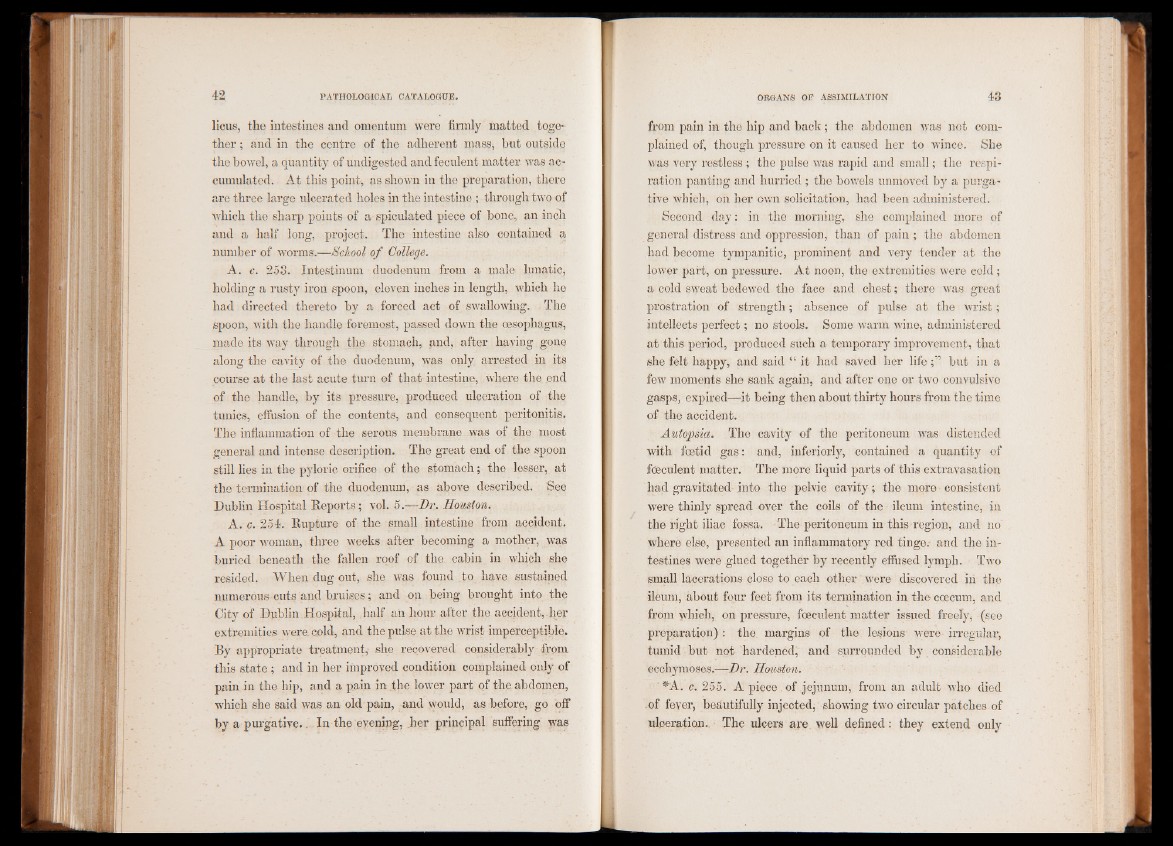
licus, the intestines and omentum were firmly matted together
; and in the centre of the adherent mass, but outside
the bowel, a quantity of undigested and feculent matter, was accumulated.
At this point, as shown in the preparation, there
are three large ulcerated holes in the intestine ; through two of
which the sharp points of a spiculated piece of bone, an inch
and a half long, project. The intestine also contained a
number of worms.—School of College.
A. c. 258. Intestinum duodenum from a male lunatic,
holding a rusty iron spoon, eleven inches in length, which he
had directed thereto by a forced act of swallowing. The
spoon, with the handle foremost, passed down the oesophagus,
made its way through the stomach, and, after having gone
along the cavity of the duodenum, was only arrested in its
course at the last acute turn of that intestine, where the end
of the handle, by its pressure, produced ulceration of the
tunics, effusion of the contents, and consequent peritonitis.
The inflammation of the serous membrane was of the most
general and intense description. The great end of the spoon
still lies in the pyloric orifice of the stomach; the lesser, at
the termination of the duodenum, as above described. See
Dublin Hospital Reports; vol. 5.—Dr. Houston.
A. a. 254. Rupture of the small intestine from accident.
A poor woman, three weeks after becoming a mother, was
buried beneath the fallen roof of the. cabin in which she
resided. When dug out, she was found to have sustained
numerous cuts and bruises; and on being brought into the
Citv of Dublin Hospital, half an hour after the accident, her
extremities were, cold, and the pulse at the wrist imperceptible.
By appropriate treatment, she recovered considerably from
this state ; and in her improved condition complained only of
pain in the hip, and a pain in the lower part of the abdomen,
which she said was an old pain, and would, as before, go off
by a purgative.. .In-the'evening, her principal suffering was
from pain in the hip and back; the abdomen was not complained
of, though pressure on it caused her to wince. She
was very restless; the pulse was rapid and small; the respiration
panting and hurried; the bowels unmoved by a purgative
which, on her own solicitation, had been administered.
Second day: in the morning, she complained more of
general distress and oppression, than of pain ; the abdomen
had become tympanitic, prominent and very tender at the
lower part, on pressure. At noon, the extremities were cold;
a cold sweat bedewed the face and chest; there was great
prostration of strength; absence of pulse at the wrist;
intellects perfect; no stools. Some warm wine, administered
at this period, produced such a temporary improvement, that
she felt happy, and said “ it had saved her l i f e b u t in a
few moments she sank again, and after one or two convulsive
gasps, expired—it being then about thirty hours from the time
of the accident.
Autopsia. The cavity of the peritoneum was distended
with foetid gas: and, interiorly, contained a quantity of
fceculent matter. The more liquid parts of this extravasation
had gravitated into the pelvic cavity; the more consistent
were thinly spread over the coils of the ileum intestine, in
the right iliac fossa. The peritoneum in this region, and no'
where else, presented an inflammatory red tinge.- and the intestines
were glued together by recently effused lymph. Two
small lacerations close to each other were discovered in the
ileum, about four feet from its termination in the ccecum, and
from which, on pressure, fceculent matter issued freely, (see
preparation) : the. margins of the lesions were irregular,
tumid but not hardened; and surrounded by considerable
ecchymoses.—Dr. Houston.
*A. c. 255. A piece. of jejunum, from an adult who died
of feyer, beautifully injected; showing two circular patches of
ulceration. The ulcers are. well defined: they extend only